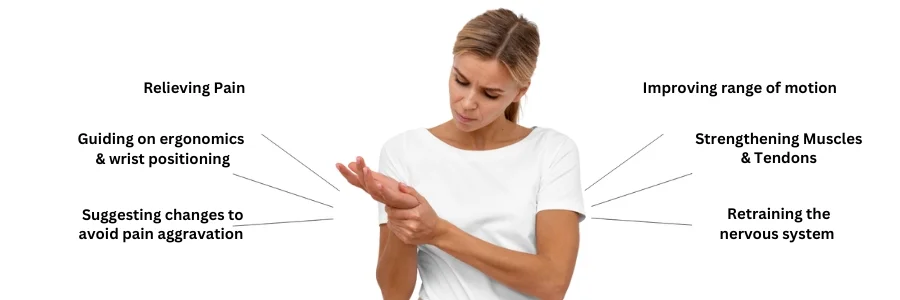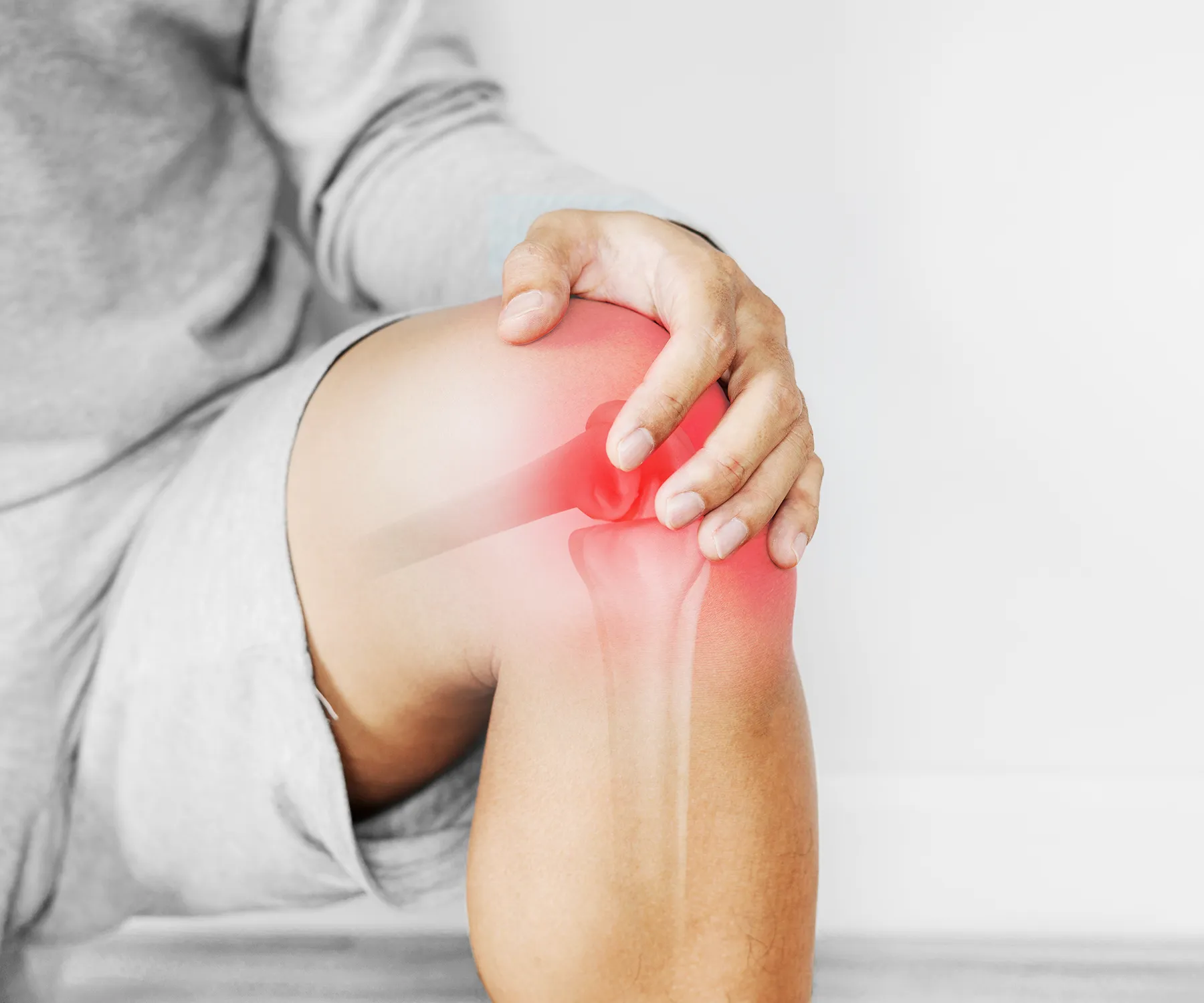
Is Wrist Pain Hurting Your Performance?
A large population around the globe working on computer or keyboards have been reported having carpel tunnel syndrome.
If you feel constant or intermittent ache in your wrists due to prolonged working hours and use of keyboard, mouse, or other computer peripherals, address the issue promptly. Access physiotherapy for wrist pain to find long-term relief.
Has this been happening to you lately?
Persistent Ache
Feeling a recurring discomfort in the wrist, whether at rest or during movement
Shooting Pain
Sharp pain especially while performing certain actions or bearing weight on the hand
Stiffness
Finding it difficult to move the wrist freely or experiencing reduced range of motion
Weakness
Noticing a decrease in grip strength or feeling instability in the affected wrist
Swelling
Noticeable swelling or puffiness in the wrist area
Tenderness
Feeling sensitivity when touching or applying pressure to the wrist
Tingling
Experiencing sensations in the hand, indicating possible nerve involvement
Difficulty with Activities
Facing challenges in performing everyday tasks or sports-related movements
What causes a painful wrist?
Repetitive movements like typing or playing sports, wrist sprains and strains from sudden impacts or falls, carpal tunnel syndrome due to nerve compression, and conditions like arthritis or tendinitis can all lead to discomfort. Additionally, wrist fractures or injuries, ganglion cysts, gout, infections, and certain medical conditions may contribute to the pain.
Physiotherapy for wrist pain helps by

FAQs related to Wrist Pain
Why does my wrist hurt when I bend it or put pressure on it?
Many things could cause wrist pain when bending or applying pressure on it. It could be brought on by an injury such a sprain or strain that develops through overuse or a sudden impact. Wrist discomfort can also be caused by ailments like tendinitis, arthritis, and carpal tunnel syndrome.
Why is my wrist swollen?
Numerous things can contribute to wrist swelling. It could be caused by an injury, such as a fracture or sprain, which would cause swelling and fluid buildup in the injured area. Conditions including arthritis, tendonitis, or carpal tunnel syndrome are additional potential reasons.
Systemic problems including infections or inflammatory diseases may occasionally also be a factor in wrist swelling. Visit a healthcare provider for an accurate evaluation and diagnosis if the swelling is prolonged, severe, or accompanied by other alarming symptoms.
How can I tell if my hand or wrist pain is due to work?
Take into account the following signs if you think your wrist or hand pain is work-related:
Notice if the pain worsens while performing certain duties or using certain tools at work, or if it does so only after doing those chores or using those tools.
If you are a working professional whose job entails typing, gripping, or using vibrating instruments repeatedly, this may be a contributing factor to your pain.
If your discomfort improves while you’re taking a break from work—during the weekends or on vacation, when you’re not working—it may be work-related. Check out other pain problems of working professionals cured by physiotherapy.
Make sure your desk is ergonomically sound to reduce stress on your hands and wrists. Consult our expert physiotherapist for further diagnosis.
What does carpel tunnel syndrome feel like?
Carpal tunnel syndrome can result in tingling, numbness, or “pins and needles” in the hands, particularly the thumb, index, middle, and half of the ring fingers. You might also notice hand trembling and find it difficult to handle little objects. Frequently, the sensations are more pronounced at night or following repetitive hand motions. It’s crucial to get evaluated by a doctor if you think you could have carpal tunnel syndrome.
Does weight cause wrist pain?
Weight can indeed lead to wrist pain. The wrist joint and its surrounding components can become stressed from carrying large objects or carrying too much weight, which can result in pain or even injury. Furthermore, diseases like tendinitis or carpal tunnel syndrome may be exacerbated by repetitive movements with extra weight.
Can painkillers treat wrist pain?
Yes, medications can cure wrist pain by giving short-term symptom relief. Acetaminophen and nonsteroidal anti-inflammatory medicines (NSAIDs) are over-the-counter painkillers that can help reduce inflammation and relieve mild to moderate wrist pain. However, it’s crucial to follow the instructions carefully and avoid depending on them as a permanent fix.
Does wrist pain require surgery?
Surgery is not usually necessary for wrist pain. Many times, non-surgical methods including rest, ice, physical therapy, and medication are sufficient to address wrist pain. However, surgery may be an option if conservative measures don’t work to relieve the pain, the disease is severe, or it involves structural problems like fractures or torn ligaments. The underlying reason of the wrist pain will determine whether surgery is necessary, and a healthcare provider can help choose the best course of action depending on the individual’s unique condition.
How does physiotherapy help with wrist pain?
Physiotherapy can help with wrist discomfort by treating the underlying reasons and supporting healing. A thorough evaluation will be performed by a physiotherapist to identify the precise problems causing the pain.
A customized treatment plan will then be developed by them, which can include physical therapy to strengthen the muscles that support the wrist, flexibility exercises, and manual therapies to ease pain and enhance blood flow.
In order to lessen additional stress on the wrist while doing daily activities, physiotherapy for wrist pain may also concentrate on posture and ergonomics improvement. Physiotherapy can speed up recovery by reducing discomfort and improving wrist function with these focused approaches.
When to see a doctor with wrist pain?
You should see a doctor for wrist pain if:
The discomfort is acute, enduring, or escalating.
You have weakness in your hand or fingers, or you are unable to move your wrist.
Around the wrist, there is swelling, redness, or inflammation.
The discomfort was brought on by a fall or another serious injury.
Home cures and over-the-counter painkillers don’t work to ease pain.
When is wrist pain serious?
Wrist pain is serious when:
It is severe, ongoing, or getting worse over time.
The wrist has an obvious deformity or is immobile.
Swelling, redness, or warmth may be present along with the discomfort and could be signs of infection or inflammation.
There is a history of severe wrist trauma or damage.
Numbness, tingling, or weakening in the hand or fingers accompany the pain.





